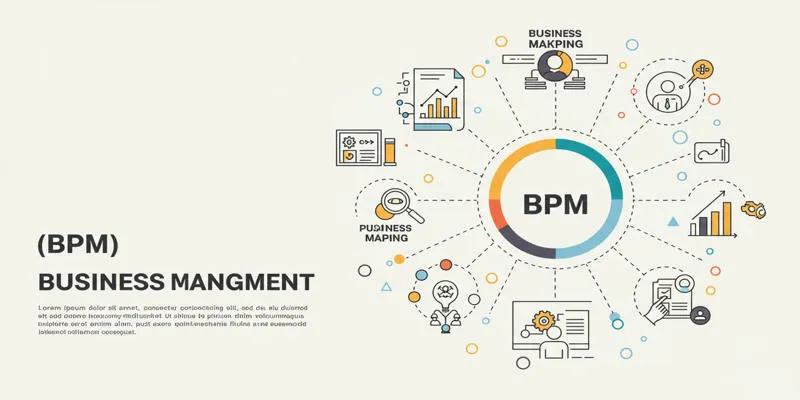What is Business Process Management (BPM), and Why Should You Care?
In today’s competitive market, organizations strive to run their operations more efficiently and cost-effectively while delivering enhanced value to customers. A key strategy to achieve these outcomes is Business Process Management (BPM). While BPM may differ from current work practices, its value is undeniable. This article explores the essential components of BPM, its advantages, and how to implement it for business success.
What is Business Process Management (BPM)?
 Business Process
Management is the systematic approach to planning, creating, monitoring, and
improving organizational processes.
Business Process
Management is the systematic approach to planning, creating, monitoring, and
improving organizational processes.
BPM enables organizations to plan and control business procedures to achieve desired outcomes. A business process encompasses all tasks performed from start to finish to produce a specific result, whether managing an order or addressing customer concerns.
BPM functions as a continuous practice, monitoring how processes align with company goals. It employs process improvement methods to integrate technical solutions with automated systems for optimal results.
Key Components of BPM
BPM relies on several elements to enhance business processes:
- Process Discovery: Identifying and mapping current operations to visualize process designs.
- Workflow Arrangement: Using flowcharts or BPM applications to create efficient workflow structures.
- Process Execution: Implementing new process designs through technical solutions or workplace improvements.
- Performance Monitoring: Tracking key performance indicators to identify areas for improvement.
- Process Optimization: Enhancing business processes to improve performance and outcomes.
Types of BPM
BPM serves three primary purposes based on how a business utilizes its processes:
- Integration-Centric BPM: Managing data connections between systems like CRM and ERP.
- Human-Centric BPM: Targeting processes requiring human intervention, such as approvals and customer service.
- Document-Centric BPM: Optimizing document handling activities, especially approvals and invoice management.
Why Should You Care About BPM?
BPM offers significant benefits to businesses of all sizes. Investing in BPM can transform your organization.
Benefits of BPM
| Benefit | Description |
|---|---|
| Improved Efficiency | Eliminates redundancies and streamlines workflows, saving |
| time and resources. | |
| Cost Savings | Reduces operational costs by automating manual tasks and |
| minimizing errors. | |
| Enhanced Productivity | Enables employees to focus on value-added tasks rather |
| than repetitive ones. | |
| Better Customer Satisfaction | Optimized processes lead to faster service |
| delivery and higher quality. | |
| Risk Management | Provides greater control over compliance and governance, |
| reducing risks. | |
| Adaptability | Helps businesses respond quickly to market changes or |
| disruptions. |
Real-World Applications
BPM is applicable across various industries:
- Healthcare organizations use BPM to simplify patient enrollment and reduce administrative workloads.
- Retail businesses leverage BPM to optimize supply chain management and inventory control.
- Finance companies use BPM to ensure compliance and enhance transaction efficiency.
How BPM Works
 To enhance business
processes, companies should follow specific BPM implementation steps. Here’s a
guide:
To enhance business
processes, companies should follow specific BPM implementation steps. Here’s a
guide:
Steps in Implementing BPM
- Identify problem areas during process evaluation and visualization.
- Align process changes with organizational goals focused on cost reduction, service quality enhancement, or profit expansion.
- Design ideal business processes using flowcharts or BPM applications to create standard procedures.
- Automate routine tasks with modern technology, including data entry and approvals.
- Track cycle times, errors, and customer feedback to measure process outcomes.
- Regularly review and refine BPM practices to maintain high performance levels.
Technologies Supporting BPM
Modern BPM utilizes advanced technologies to enhance process control:
- Artificial Intelligence (AI): Enables predictive analytics and intelligent decision-making.
- Machine Learning: Analyzes complex processes to identify patterns that boost performance.
- Cloud-Based Platforms: Offer scalability, flexibility, and collaboration capabilities.
- No-Code Solutions: Allow users without technical expertise to create BPM processes easily.
The Role of Technology in BPM
- Automation tools such as Robotic Process Automation (RPA) and AI streamline workflows.
- These tools monitor operations and adjust them for optimal results.
- BPM software integration with legacy ERPs and CRMs presents challenges and opportunities.
- Technology enables BPM systems to adapt and evolve with organizational needs.
The Impact of BPM on Organizational Success
- Operational excellence results from improved business process design.
- Enhanced decision-making through better visibility into workflows for strategic decisions.
- Streamlined operations yield quicker, more reliable customer service.
- Competitive advantage through agility, innovation, and adaptability in a dynamic market environment.
Challenges in Implementing BPM
While BPM offers substantial advantages, it presents specific challenges:
- Resistance to new work practices and systems among staff members.
- Complex processes in large organizations require comprehensive process mapping for analysis.
- Initial capital investment in BPM tools and staff training can be costly.
- Automation of flawed processes can replicate existing errors instead of solving them.
Organizations should provide thorough training and start small with their BPM initiatives.
The Future of BPM
The future of BPM is shaped by digital transformation:
- BPM tools enhanced by AI will enable better decision-making and real-time process improvements.
- Low-code/No-code platforms make BPM accessible to all users, speeding up deployment.
- Process improvements will enhance customer interactions through better service delivery and faster responses.
- Technology helps companies maintain compliance and improve sustainability.
Conclusion
Business Process Management empowers organizations to optimize their operations, reduce costs, and deliver superior products to customers. By adopting BPM strategies, organizations can achieve better operational results and maintain flexibility. Today, implementing agile BPM practices is not just an option but a necessity for organizational survival and growth.
Related Articles

Creating OneNote Notes from Notion Databases

The Best Free Small Business Software in 2025 to Run Smarter, Not Harder

Speed Up Contact Form Follow-Ups with Automation

Syncing Apple Reminders with Microsoft To Do

6 Ways Businesses Are Using AI in eCommerce to Stay Competitive

AI in Customer Service: 11 Ways to Automate Support and Boost Efficiency

Unlock the Power of Automation: 6 Ways to Automate Microsoft Excel

Transform Your HR Department with These 6 Automation Strategies

Boost Engagement: 8 Ways to Automate Your Email Newsletters and Drip Campaigns

Enhance Your Customer Support with These 6 Automation Strategies

Top HubSpot Alternatives for Small Businesses in 2025

The Best Email Drip Campaign Software: Top Picks for Seamless Automation
Popular Articles

The 8 Best HubSpot Alternatives in 2025 for Smarter Growth and Less Hassle

The 8 Best Event Management Software Platforms to Simplify Your Planning

Choosing Between Calendly and Doodle: Which Tool Suits Your Needs

ShotCut Video Editor: A Simple and Reliable Free Tool for Video Editing

Top Online Tools to Easily Convert OGG to MP4

Elevate Your Facebook Presence with These Cover Photo and Video Tips

Unlocking Creativity: The Best Free AI Tools for Image Generation

Best AI Anime Upscalers Reviewed: Which One Stands Out?

Discover the Top 10 Fastest Web Browsers to Use in 2025

Recording DVD Movies with VLC: Simple Methods You Can Use

Convert Olympic Footage for iMovie on Mac: 7 Proven Methods

 mww2
mww2